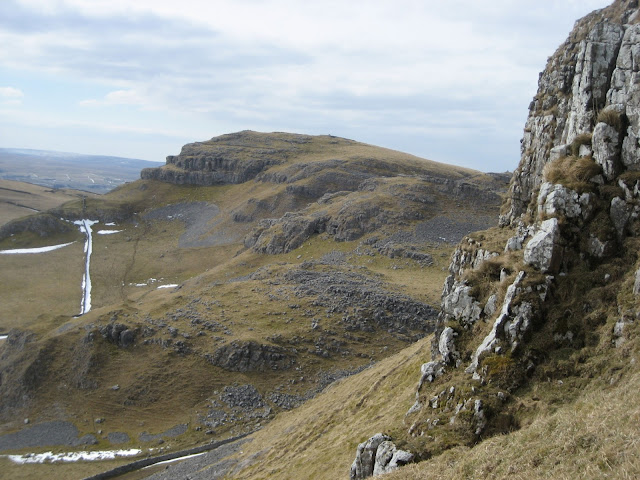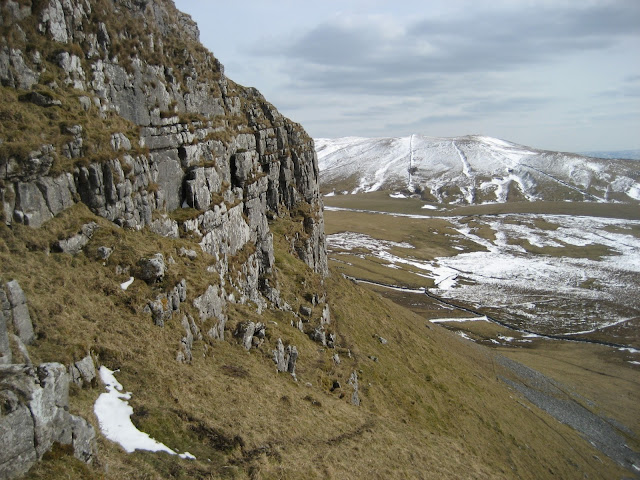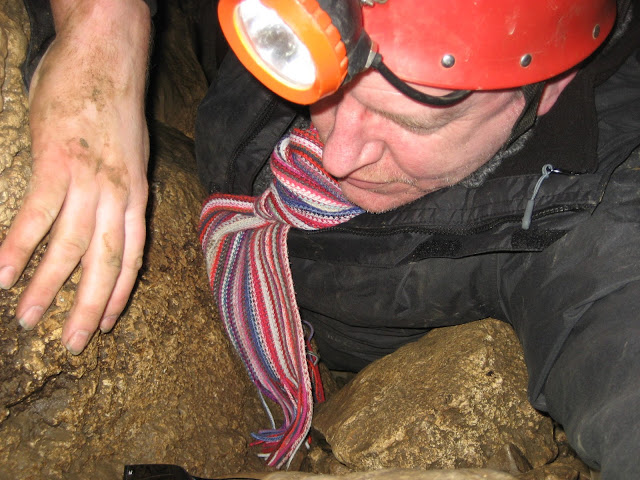Attermire Cave - the Keyhole in the Cliff
For a lover of wild, exciting places - it doesn't get better than this. Attermire Cave is a slot or 'keyhole' high up in the scar above Settle. It is famous for its Romano-British and earlier finds - most notably the remains of a chariot, for its jewellery, human bones .... and for its nasty crawl known as the 'neck'. To reach it, you have to head up the scree then edge gingerly along that grassy ledge. How they carried a chariot or a body up here is beyond me. He must have been an important guy.
The entrance, when you do get there, is stunning. The sediment you can see just inside was where Tot Lord and his companions uncovered the remains of the chariot in the 1920s. At this height and away from water, it is unlikely the cave was lived in for long periods of time. More likely, it was used for storage, burials and religious practices.
Let's just get a sense of where we are. Attermire Cave is the 'keyhole' up on the right, above the scree. The cave on the clifftops at centre is Lookout Cave, reached by climbing that grassy slope between the cliffs, if you don't mind heights, that is. The gap in the cliffs can be seen immediately above those two distinctive snow patches at the base of the scree.
Click to see the expansive view over the area between the Craven faults.
Once up at this height, the Yorkshire Dales can rival the Lake District for grandeur. No doubt about that. Every step upwards gives a breathtaking view. That's Warrendale Knots in the background, following the line of the Mid-Craven Fault.
The height, and sense of exposure, are terrific. So is the sense of freedom. I love this place.
Heading between the cliffs as promised, a glance to the right shows the narrow and seemingly impossible grassy ledge to Attermire Cave. Beyond is Rye Loaf Hill, dusted with snow, and the flat area between once contained the lake of 'Attermire' itself. The name may derive from 'otter', but this is a matter of debate.
The view across Ribblesdale to the Ingleborough massif is impressive. In the foreground, blankets of glacial till can be seen covering the Great Scar limestone.
This beautiful exposed block of limestone provided a great contrasting colour to the backdrop of Warrendale Knots, and the distant view extends as far as Morecambe Bay.
Lookout Cave is in a precarious position on the very top of the scars. Ten feet outside the entrance is a 100 foot drop, so great care is needed. It's not called 'Look Out' for nothing!
The cave has an exquisitely symmetrical entrance. It is an ancient feature, hollowed out by water action long before glaciers deepened the valley floors. It must have provided a great shelter for early man.
And here's the reason why. In my opinion, the finest view out of any cave entrance in Yorkshire. Pendle Hill, twenty miles away, looks like a distant ship on the ocean.
The further in you go, the more impressive the entrance appears to be.
This is my favourite picture of the three. The entrance rocks hang like curtains framing a stage with a scenery out of this world.
The dangerous situation of the cave entrance can be seen on this photo. The cave itself is hidden just below and to the left of the limestone outcrop right of centre.
A quick look at the immediate surroundings!
After enjoying Lookout Cave, I wandered down between the cliffs to pick up the grassy ledge leading to Attermire Cave itself. The ledge looks shockingly risky from this angle, but is actually easy with care. Even young children can manage it as long as they are supervised.
First impressions of Attermire Cave entrance. Hard to imagine a torrent of water once gushed out of here.
Inside the cave a large boulder is wedged across the passage. Passing underneath is straightforward enough.
Close-up of the entrance sediment, from which the chariot was excavated. Also discovered were brooches, a Roman hanging lamp stand, coins - both Roman and Anglo-Saxon, and both human and animal bones. It is likely that Celtic peoples hid their valuables in this remote location during the Roman occupation, but the human remains date back as far as Neolithic times. Certainly, this is a sacred place.
One of the bronze loop-wired brooches found in Attermire Cave and now in Leeds Museum. It dates from the Romano-British period. The cave is impressive for its wealth of finds.
The view out isn't bad either.
The inviting passageway is daubed in places with graffiti from early explorers.
The 'moonmilk' on the ceiling is far more attractive. Top centre is a white rabbit with two staring eyes and outstretched paws.
Another view of Attermire Cave's calcite and 'moonmilk' formations - taken in pitch black conditions and lit up with my caving helmet lamp and 'night vision' flash.
The flash soon had these fellas moving. Meta menardi - a common spider of the daylight threshold in caves - met a homo-sapiens.!! I don't know who was the most shocked.
The Tissue Moth Triphosa dubitata is a lovely sight on the cave walls with its pinkish colouration. These moths use the caves for hibernation and have delved a little deeper than usual this year. Who can blame them?
The passage soars to over 30 feet in height.
Then the way ahead suddenly starts to lower. I never have been able to explain the hose-pipe. It's definitely not Neolithic!
A squeeze past this impressive flowstone curtain ...
.. then things get very low indeed. Ridiculous, in fact. Tot Lord and his friends in the 1920s thought nothing of crawling through here.
My 6' 4" frame and wider middle than a few years ago managed half way or so ...
.. until I encountered the 'neck' and, being alone, decided it was wise to come back another day with company. Besides, I had the jitters and the floor was awful to crawl on. Beyond the 'neck' is a chamber floored by a pool, and there's then about as much cave again - so it will be worth coming back. There are days when you wish you were smaller. This was one.
My panting and heavy breathing created steam in the passage as I headed out.
But this still didn't stop me from admiring the formations.
And having a last look at the impressive wedged boulder.
The full survey of Attermire Cave shows the location of the pool chamber and, by examining E and F, the constricted nature of the 'neck.' As much cave again lies beyond and is full of old graffiti, so the Victorians must have been braver - or considerably slimmer round the middle! Click Here to link to the Northern Caving Clubs Cave Maps website.
Just below and to the east of Attermire Cave is the imposing entrance to Horseshoe Cave. It overlooks an ancient settlement in the valley below. Inside are wedged boulders making progress difficult. It doesn't extend very far and eventually links up with Attermire Cave - just inside the entrance.
The wonderful view out of Horseshoe Cave with its tapering entrance rift.
A last look back at Attermire Scar and Cave. Horseshoe Cave is hidden in the cliff on the extreme right.
And finally .. a glance back to Warrendale Knots - majestic features in an unforgettable landscape.
I would love to discuss any of your experiences at Attermire Cave. Feel free to drop me a line. Remember to take great care inside the cave and not disturb the delicate deposits.
oldfield.08@virginmedia.com
Stephen x







































No comments:
Post a Comment